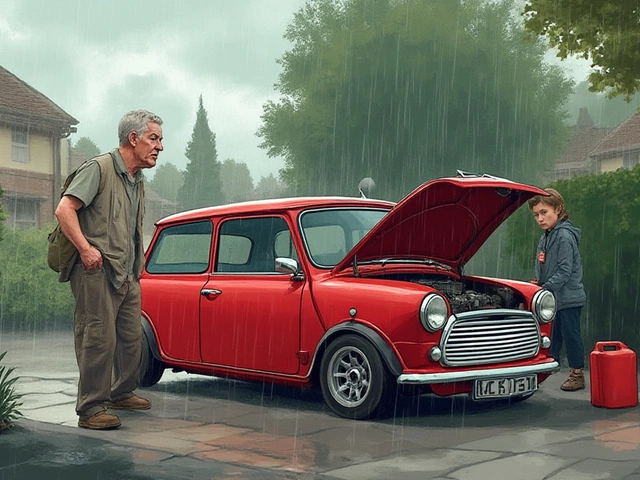Picture this. You’re merging onto the freeway, pressing down on the gas, expecting your car to surge forward. Instead? The engine coughs, jerks, or just doesn’t respond. Sometimes, it even dies while you’re sitting in traffic. These aren’t just random gremlins in your ride—they’re classic red flags your fuel pump might be living on borrowed time. When a fuel pump starts to fail, it doesn’t typically collapse in one dramatic swoop. It dies a slow, awkward death, making your daily drives unpredictable and a bit nerve-wracking. There’s no joy in wondering if your car will roar to life every morning or leave you stranded at the grocery store. What really happens under the hood, and how does your vehicle act when this little pump starts to give up the ghost?
Common Symptoms: How a Bad Fuel Pump Makes Your Ride Act Up
First up, let’s unpack how your car reveals this hidden struggle. The most obvious symptom? Intermittent sputtering. You might notice the engine suddenly loses power—just for a moment—before lurching back to normal. Usually, this shows up when you’re climbing hills, accelerating quickly, or hauling extra cargo. Imagine your buddy’s old pickup hiccuping every time he tried to pass someone on a country road. That’s textbook fuel pump behavior.
The next signal is hard starting. You turn the key, and the engine cranks and cranks, but it doesn’t catch right away. Sometimes, after five or six tries, it finally grumbles to life. This can fool you into blaming the battery or ignition system, but the cause often sits in the gas tank. The fuel pump is struggling to keep up. Another symptom? Sudden loss of power, especially at high speeds. You’ll feel the car lurch, hesitate, or even cut out, especially after driving a while or when the temperature under the hood ramps up.
Stalling is another notorious sign. This isn’t the kind where you let off the clutch wrong; it’s a dead-stop with no warning. The car might restart after cooling down, but that relief is short-lived. Each time it happens, you’re rolling the dice. Fuel pump problems love to show up once the system heats up. When you get stuck on a hot day in bumper-to-bumper traffic and the car randomly gives up, you’ll wish you’d paid attention sooner.
Other clues include weak acceleration, a whining noise from the gas tank area, and even decreased fuel efficiency. Strangely enough, some cars will even refuse to start on hills. That’s because the pump can’t push fuel with enough pressure to reach the engine, especially when gravity’s not helping. If you hear a persistent high-pitched whine coming from the rear of your car, don’t ignore it.
Let’s get concrete. According to a 2023 survey by CarMD, stalling and starting issues caused by fuel system failures—fuel pumps, filters, regulators—made up nearly 11% of the top reported problems in vehicles equipped from 2010-2020. That’s not an isolated bunch; it’s millions of daily drivers. If you’re noticing one—or several—of these symptoms, start with the basics before springing for an expensive diagnosis. Change your fuel filter first. If that doesn’t improve things, the fuel pump could be the culprit.
Here’s a quick cheat sheet for common symptoms:
- Sputtering at high speeds
- Hard starts, especially after sitting overnight
- Unexplained drops in acceleration power
- Abrupt stalling, mostly during heat or long drives
- Unusual whining noises from beneath the rear seat or trunk
- Drop in gas mileage for no clear reason
Got one or more of these? Keep reading. The trouble might not stop here—ignoring the symptoms can lead to bigger headaches (and bills) down the road.

Understanding the Fuel Pump: Why It’s Critical and How It Goes Bad
The fuel pump’s job sounds simple: push fuel from the tank to the engine at exactly the right pressure. But there’s no room for error. Even a slight drop in pressure and your engine runs lean, misfires, or just stalls out. Older rides used mechanical pumps, while most vehicles since the mid-1980s rock electronic pumps sitting inside the gas tank. Modern pumps are tiny, but they’re workhorses. Many spin at 4,000 RPM to keep up with demand.
Why do fuel pumps fail? Heat is the top enemy. When fuel levels run low, the pump isn’t cooled properly by the gas around it and starts running hotter. Do you run near empty a lot? You’re risking an early pump death. Dirty or low-quality fuel can also gum up the works, bogging down the pump with crud. According to AAA’s 2022 research, poor-quality fuel contributed to 4.5% of fuel-pump-related breakdowns in North America just that year. That’s a solid reason to skip off-brand pumps or outdated gas stations that don’t replace filters often.
Another big factor is simple wear from old age. Fuel pumps are all about moving parts—tiny internal gears, rollers, or blades spinning thousands of times per minute. After 100,000 miles or so, the internal tolerance drops, and pressure output falls. Some folks get more than 200,000 miles from a pump with good habits, while city cars that run on fumes might blow one at 60,000 miles. Quick tip: OEM (original equipment manufacturer) replacement pumps cost more up front but usually outlive no-name options from big box stores.
Here’s what goes on when the pump goes out: as the internal mechanisms wear, the pump delivers less fuel pressure. The engine control module (ECM) tries to compensate by adjusting injectors and timing, but it can only do so much. Eventually, the fuel/air mix goes lean, and you start feeling misfires, stutters, or sudden stalls. Rarely, the pump just dies instantly, but gradual failure is the norm.
Don’t forget about clogged fuel filters or lines. Sometimes, the pump gets blamed for pressure loss that’s actually due to a filthy filter. That’s why proactive car owners swap the filter with every fourth oil change (older cars) or at 30,000-40,000 miles (newer rides) if serviceable. If your ride doesn’t have an external replaceable filter, the strainer in the tank can still gunk up—especially if you let the tank run low and pick up sediment.
Wondering about the warning signs? Here’s a handy chart comparing some of the most telltale symptoms and how often they pop up, according to a 2024 study of dealership repair data:
| Symptom | Frequency in Failing Fuel Pumps |
|---|---|
| Engine Sputtering | 73% |
| Hard starting | 56% |
| Stalling | 49% |
| Loss of power under load | 64% |
| Fuel pump whining noise | 41% |
If you’re troubleshooting, resist the urge to just swap out the pump. Test fuel pressure with a proper gauge—on most vehicles, that should read between 40-60 PSI at idle. If you’re below spec, try replacing the filter first, then check voltage at the pump. Sometimes, a corroded ground wire or weak relay is really to blame, and you don’t want to be the guy who spends $300 on a part you don’t need.

Practical Tips to Prevent (or Survive) a Fuel Pump Failure
Good news! You don’t have to just cross your fingers and hope your fuel pump keeps humming. A few simple habits can knock years of trouble off your plate. First off: stop running on empty. Keep at least a quarter tank of gas. The fuel actually cools the pump—run low too often, and the pump overheats, wears out seals, and risks total failure. Ask any trusted mechanic and they’ll confirm: this is the number one way to stretch your fuel pump’s life.
Next, use quality fuel. If you see a random truck refilling tanks at the gas station, skip the fill-up or wait an hour. That's when sediment stirs up and can clog your filter or strainer. If your car sits for weeks between drives, consider adding a fuel stabilizer to ward off varnish and deposits. For those who drive older rides, swapping the fuel filter every 30,000 miles is cheap insurance. Don't wait for engine problems—keep that schedule, and you buy your fuel pump extra breathing room.
If your pump does start to act up, carry a can of starting fluid. Let’s say you stall out and can’t restart at all—spray a small amount into the intake. If the engine catches briefly, it confirms the problem's somewhere in the fuel delivery, not the ignition or engine itself. This trick isn’t a fix but helps narrow down what's going on quickly if you’re stranded.
If you smell raw fuel or see leaks from the tank area, don’t drive the car. It’s rare, but a failing fuel pump can lead to pressure spikes that split lines. Under pressure, any raw fuel is an instant fire hazard. Get a tow—don’t risk it.
When it comes to replacement, don’t cheap out if you want long-term reliability. As of this year, average replacement costs from reputable shops range from $450 to $1,100, depending on vehicle make, labor, and part quality. That stings, but pay for the good part once and it’ll likely last beyond the next new set of tires. DIY types can save hundreds but beware—getting to in-tank pumps often means dropping the fuel tank. Unless you know what you’re doing, let a pro handle it.
One more hot tip: if your car features an in-line fuse or fuel pump relay (many do), check those before swapping parts! Sometimes, a $10 relay goes bad and mimics every symptom of a dying pump. Pull the relay, give it a shake—if it rattles or smells burnt, replace it before tearing into the tank.
Here’s a quick step-by-step if you suspect your fuel pump going out:
- Listen for the pump: With the key turned to 'on' (not start), listen near the tank. A healthy pump emits a soft whir. Silence could signal a bad pump or a blown fuse.
- Check for codes: Many modern vehicles will throw a trouble code (P0230 to P0232 for fuel pump circuits).
- Test the fuel pressure: Use a fuel pressure gauge at the rail, compare to factory spec.
- Inspect the fuel filter: If it’s old or clogged, swap it out—sometimes, this cures the issue entirely.
- Check relays and fuses: Look for burned or loose connections in the fuse box.
If all else fails, call in a mechanic. No shame in getting a definite diagnosis. Remember, left untreated, a dying pump can leave you with a dead engine at the worst possible time: highway merge lanes, hot summer afternoons, or even a dark winter night far from help.
Knowing what to look for—down to the unique sounds and stutters—saves hours and money. Listen to your car’s complaints and deal with them before your daily drive turns into a horror story.
